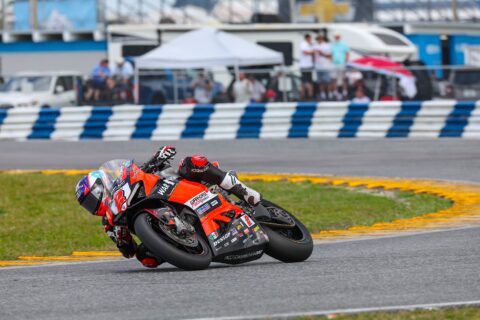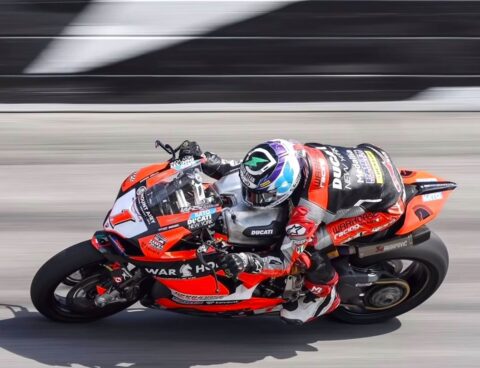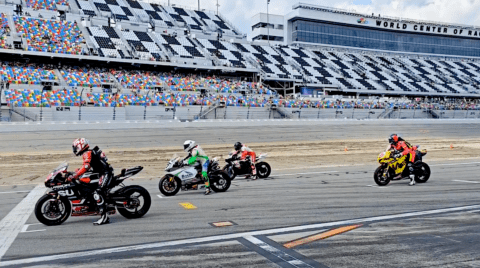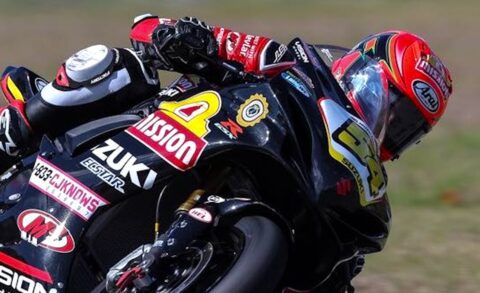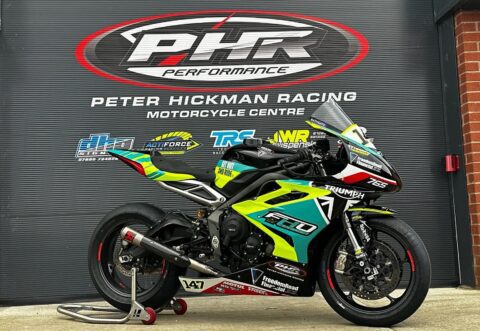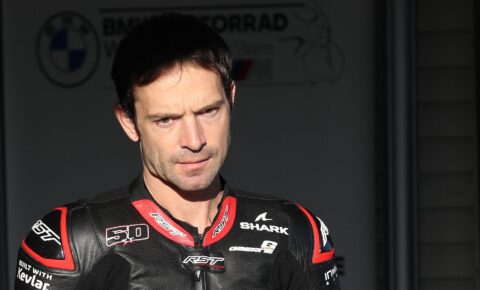Biplane wings create more downforce than Ducati’s MotoGP bike. It’s lighter than the factory’s World Superbike V4. Its quoted power with the race exhaust is 234bhp. And, yet, you can ride it to the pub.
Dry weight is 159kg, a huge 16kg weight saving over the standard V4 Panigale, a class-leading bike in its own right. Peak power is 224bhp in standard road trim, or 234hp with the supplied race exhaust, which is only around 10bhp short of the factory’s World Superbike V4-R.
The Superleggera is actually lighter than the race bike and its huge bi-plane wings create more downforce than even Ducati’s current GP20 MotoGP machine. Despite its V4 Stradale motor revving to 16,500rpm, service intervals are at a perfectly normal 7500 miles.
Two Mugello lap times tell the true story. Michele Pirro, a Moto2 race winner who finished seventh in MotoGP at Mugello in 2019, set a best lap in the Italian Superbike race of 1.50.3 on his race-prepared V4.
Meanwhile, Alessandro Valia, the highly skilled Ducati test rider, on the same tyres as Pirro but aboard the Superleggera with race kit, managed 1.52.45. That’s just two seconds in it (on a long lap). And the Superleggera was running standard gearing and gearbox, road-compound brake pads and so on. Simply by optimising the gearing for the Tuscany track Valia would have shaved off another second a lap.
So don’t be fooled into thinking this is ‘just’ a Panigale with a race pipe and big wings. No, this is an entirely new bike from the ground up.
It is, for starters, the world’s only homologated bike with a carbon chassis (which saves 1.2kg over the standard bike). Carbon wheels account for another 3.4kg saving, overall 16kg lighter than standard. Even with its homologated power output of 224bhp, that’s enough to give the it record-breaking power to weight ratio of 1.41hp/kg.
We have to discuss the huge bi-plane wings. The distinctive and, I would say, attractive wings are fascinating and directly derived from MotoGP. Back in 2016, there weren’t any restrictions in the size and shape of the wings, which means the GP16, Ducati’s last MotoGP bike before downforce-curbing regs were introduced, had the most effective wings of all time. In fact, the downforce created by the Superleggera is higher than the GP20, a bike that must conform to strict regulations on size.
At 270kph the wings produce 50kg of downforce, 20kg more than the current Panigale with its single wing. At 300kph that’s up to 61kg, around the same weight as a typical MotoGP rider, and a colossal amount of downforce – enough to improve stability and reduce wheelies, thus allowing better acceleration, braking and corner entry.
The electronics package is all-new because simply transferring the electronics from the current Panigale R to the lighter, more powerful, extra downforce Superlegerra wouldn’t work. As you’d expect, it gets the full portfolio of goodies:
cornering ABS, slide control, traction control, anti-wheelie, launch control, an up and down quick-shifter, and changeable engine braking strategies. Rider aids can be trimmed and changed to meet personal demands while Ducati has also added three additional new rider modes, simply A, B, and Sport – two are track specific, the third for the road.
There’s also a new RaceGP dash mode, for track use only, which shows your lap times, splits, and riders aids. Pre-programmed tracks are already saved, like Mugello, so you can simply work on improving your lap time and splits.
Once out of pit lane the clutch is now redundant as I fire in a few quick gearchanges towards turn one. The bark between fast gear changes sounds like a gun going off and echoes around the grandstand.
It’s over 30 degrees out here and the Pirelli slicks have been scrubbed and been cooking on warmers, so there’s no need to take it steady. Immediately the carbon-chassis of the Superleggera wants to turn, feeling light, accurate, and fast steering. Out of turn five, I’m recalibrating to sheer intensity of the V4’s power and torque, yet only tickling the throttle.
This Ducati might have the power of the factory’s WSBK contender, or near as damn it, but it’s usable and smooth. I’m a little rusty from the enforced layoff and braking and accelerating at the wrong points, but the bike is allowing me to so without a hint of complaint.
On the long straight I tuck in behind the sizable screen, tap the gears, push my arse up against the bump stop and enjoy the ride. The liquid smooth Stradale motor loves to rev, while upshifts are almost seamless and incredibly quick. Each flick of left foot smacks me in the head with another tidal wave of power. Yes, Mugello is over five kilometres long but has never felt so short or so fast.
I start to gel with bike and circuit but despite getting into the flow and really starting to make the engine scream, the front end remains planted. In my chosen race B riding mode there’s no hint of a wheelie or instability and feels more like playing an Xbox game.
Mugello is wide and open but still the Superleggera shrinks it to the size of Cadwell Park. Now I’m only changing gear when the shift lights illuminates, but in no time at all I’m in fifth gear and tap into top before that notorious blind rise. Fast bikes get famously flighty over the crest, some even weave as the suspension extends, but the winged Superleggera is rock-solid and clearly loving those 60-odd kilos of winged downforce.
Then hard on the brakes into turn one and back down the gears. The Brembo Stylema R calipers grab the 330mm discs like a great white shark holding onto a seal, yet the forks take the strain, and again the stability is impeccable. The limiting factor isn’t the brakes but the rider. I don’t know of any other bike that can brake this late and remain so planted.
The wings are obviously adding to this stability, but so is the carbon fire chassis, which now has more flex and feel than before. Everyone knew this Superleggera was going to be fast, after all the figures stand out for themselves, but like the braking, I didn’t expect the handling to be so far ahead of the game.
I’ve ridden monstrously powerful WSBK Ducatis before and even congratulated Chaz Davies on size of his testicles after sampling his animal Superbike at Imola a few years ago. This Superleggera, however, is incredibly forgiving and easy considering its jaw-dropping power.
As my bravery and confidence improve I opt to flick to A mode, which delivers full power and torque in the lower gears. To be fair, Mugello isn’t a wheelie-happy track (I only used first gear to leave pit-lane) but in this sharper mode there’s certainly more kick lower down. But again the front is unflustered, only lifting slightly on the first application of throttle when the wings aren’t really working at low speeds.
Verdict
Yes, it’s priced at £86,000 and Ducati are only making 500 of them. And, sadly, some will never be ridden in anger. But beyond these negatives I can’t find any faults. This is a genuine superbike for the road, a machine capable of lapping within a few seconds of a topflight factory race bike and, incredibly, ridden on the road. However I doubt you’ll ever see one outside your local Tesco…
Spec Feck
Engine
Capacity: 998c
Type: 90º V4 Stradale, 16v desmodromic timing, liquid cooling
Bore & stroke: 81 x 48.4mm
Compression ratio: 14.0:1
Fuelling: Electronic fuel injection system. Twin injectors per cylinder. Full ride-by-wire throttle bodies, with aerodynamic valves. Variable length intake system
Transmission: Six-speed
Clutch: Dry, slipper
Final: drive Chain
Performance
Power: 165kw/224hp standard 174kw/234hp @ 15,500rpm with race exhaust (claimed)
Torque: 116Nm/85.6lbft standard 119Nm/87.7lbft @ 11,500rpm race exhaust(claimed)
Top speed: 300km/h /estimated)
Fuel consumption: 8L/100km (claimed)
Electronics
Rider aids: ABS Cornering EVO Ducati Traction Control (DTC) EVO 2 Ducati Slide Control (DSC) Ducati Wheelie Control (DWC) EVO Ducati Power Launch (DPL) Ducati Quick Shift up/down (DQS) EVO 2 Engine Brake Control (EBC) EVO
Chassis
Frame material: Carbon
Frame type: Front frame
Rake: 24.5 degrees
Trail: 100mm
Wheelbase: 1480mm
Suspension
Front: 43mm pressurised fork, billet fork bottoms, lightweight springs, fully adjustable. 120mm travel
Rear: TTX36 monoshock, with GP valve and titanium spring, fully adjustable 130mm wheel travel.
Wheels & brakes
Wheels: Carbon
Front: 17 x 3.5 Rear: 17 x 6.0
Tyres Pirelli Diablo Supercorsa SP
Front: 120/70ZR17
Rear: 200/60ZR17
Brakes: Brembo, cornering ABS
Front: Twin 330mm discs, four-piston radial Stylema caliper
Rear: Single 245mm disc, two-piston caliper
Dimensions
Weight: 159kg (dry, claimed) 152.2 with racing kit (Claimed)
Seat height 835mm
Fuel capacity 16
servicing & warranty
Servicing
First: 1000km
Minor: 12000km
Major: 24000km
Warranty: Two years, unlimited km


